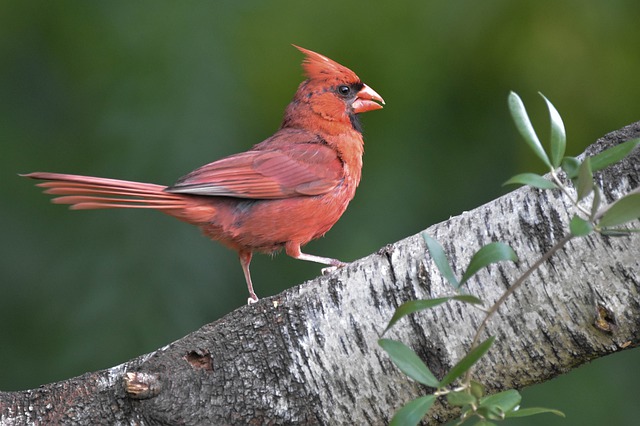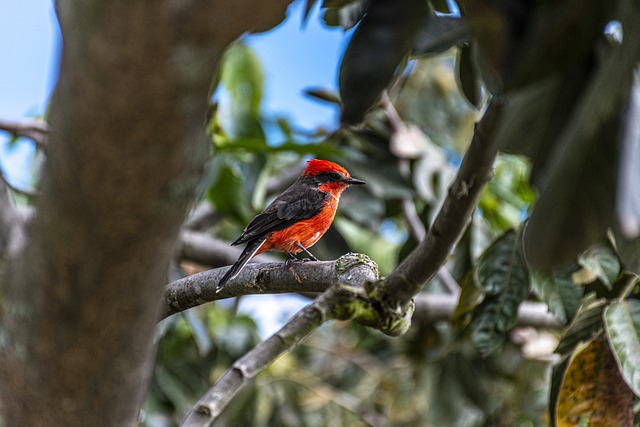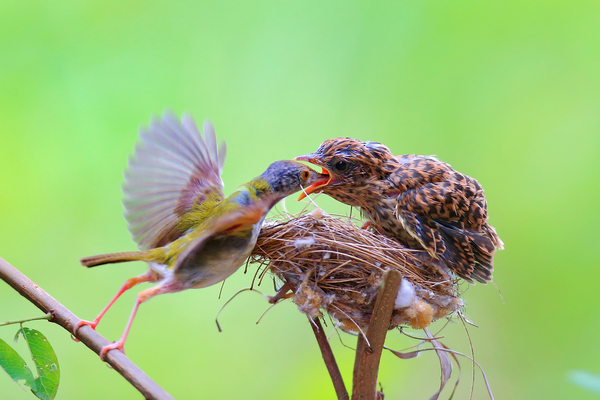Cardinals are undeniably among the most instantly recognized birds on the planet. Red feathers, a black mask over their cheeks, a distinctive crest, and a very small cone-shaped beak characterize these medium-sized birds.
Where do cardinals nest at night? This is a typical topic regarding these birds. We attempt to provide an answer to that question in this post.
Even though these birds are known for their striking red hue, only the males have it. Female cardinals, on the other hand, have grey hues across their body and a considerably duller tail and wings than male cardinals.
Where Do Cardinals Nest?

Cardinals are timid birds who prefer to lay their nests in more secluded areas with thick vegetation. They enjoy quiet regions with a lot of foliage or thickets.
These amusing birds may be seen hopping around on the ground but can also be heard from higher up in the tree. Cardinal nests can be found as low as one foot above the ground and as high as 15 feet.
They hunt for thick vegetation where they may hide their nests from predators. Because they are water-loving birds, they will want to build their nest as close to the water source as feasible.
Cardinals like to nest among bushes and saplings with lower but heavily covered foliage, such as blackberry brambles, spruce, and dogwood.
Cardinals are relatively widespread in the United States, so finding one perched or flying around is not difficult. This poses the issue of how to entice these lovely birds to visit your yard or birdfeeders.
What Do Cardinals Do At Night?

Cardinals visit feeders early morning & late in the evening. Cardinals are generally found sleeping peacefully during the night. At night, though, it’s not uncommon to hear these birds singing extremely loudly.
When these birds sing at night, it is almost always an alarm cry. They’re trying to warn the other birds that someone has broken into their domain. It’s important to keep in mind that, unlike other songbirds, cardinals don’t need much sleep at night.
Before the sun rises, both males and females will sing loudly all night and into the morning.
Where do Cardinals Usually Make Their Nests?
Cardinals are timid birds; thus, they prefer to build their nests in more isolated locations than other birds. These areas are frequently densely forested, thickets, or densely populated with shrubberies.
Most of the time, you’ll hear these birds singing from up in the trees, but you’ll also see them hopping around on the ground.
Cardinals are water-loving birds, so keep that in mind. As a result, it is not uncommon to see these birds near water sources such as streams.
After the wooing stage is finished, the female cardinal will begin building a nest out of weed stalks, bark strips, twigs, vines, and fine grass, which they normally line up quite beautifully. Cardinals are usually recognized as resident birds, meaning they do not migrate.
As a result, you’re more likely to observe these birds in the same location as you did in the winter. A cardinal nest can be found at least one to fifteen feet above the ground, based on the region of the nest.
It’s worth mentioning that cardinals, like the majority of birds, don’t reuse their nests. Cardinals normally build a new nest each year; in this instance, however, they may bring some of the old materials with them and utilize them to construct the new nests.
It may surprise you to learn that the female cardinal carries out the majority of the nest-building duties. However, in other circumstances, the man will bring the female some building supplies.
What Trees Do Cardinals Build Their Nests In?

Because cardinals do not make their nests high in the trees, they are unlikely to be found there.
When they do build on trees, they generally do so in saplings or on the basal portion of big trees.
Cardinals like to build their nests in the following trees and shrubs:
- Pines
- Hawthorns
- Dogwood
- Spruces
- Elms
- Cedar (red)
- Brambles of blackberries
- Bushes of elderberry
- Blueberry bushes
- Spicebush
- Hemlock
- Honeysuckle
- Bushes of roses
The Hunt for the Ideal Cardinal Nesting Site
Female cardinals are in charge of finding and constructing a new nest, but they are not alone in this endeavor.
Two weeks before the female is ready to use the nest, the male search for a new nesting site. With the man in tow, the female starts on a search for good spots.
Female Northern Cardinals seek a nesting location with plenty of food supplies, protection from predators, and proximity to flowing water. This might be in the shrubbery of an open field, the forest borders, a suburban garden, or even a green metropolitan park.
Why Do Cardinals Make Nests?
As with many bird species, having a safe house with plenty of predator protection in which to rear a family is essential. They like to hide in places that are not clearly visible and high enough to protect them from ground predators.
The mating season for cardinals runs from March through September. The female will deposit 2-5 eggs every breeding season. The eggs are off-white in color and have black markings on them. The female will incubate the eggs once they have been placed in the nest.
The eggs are usually deposited within a week of the nest being erected by cardinals. After all of the eggs have been deposited, the incubation process will begin immediately.
The female may sit for brief periods of time while laying eggs, but she is always on the go, coming and departing from the nest.
The male is in protection mode as the female attempts to lay the last egg. The male ensures that the nest is safe and that no predators pursue his spouse.
Check out this article When Do Cardinals Lay Eggs? for full information.
Do Cardinals Reuse a Nest?

Cardinals in some of the southernmost states will attempt to have two or even three broods over the spring and summer months.
Despite the fact that cardinals have a busy mating season, they do not save time and energy by recycling their nest. Each brood of northern cardinals necessitates the construction of a new nest.
This does not, however, preclude you from keeping cardinals in your yard for the time being. In fact, these devoted parents frequently construct their nests in the same location.
This makes it obvious why seek a new place when they already have one with lots of food, safe shelter, and bubbling water nearby? Cardinals, like people, have a preferred location.
In addition, during incubation, the female cardinal is reliant on the male cardinal for nourishment. She simply leaves the eggs for a few minutes to allow the male to feed them.
The male stays for up to two weeks after the mother has abandoned her young to feed them. That is why constructing a second nest close is likewise more efficient.
What Does a Cardinal Nest Look Like?

Cardinal nests are shaped like a cup and feature four distinct components. Each layer is built from found items in the area.
The hardest layer is the outside, which is formed of flexible twigs and occasionally human waste. After that, a layer of leaves is applied, followed by a covering of soft bark.
Pine needles, grass, rootlets, or plant stems make up the inner layer, where the eggs will be laid. These materials provide cushioning.
The nest is approximately 4 inches across overall, with a 3-inch inside. The nest, by comparison, is just approximately 2-3 inches deep.
Conclusion
Cardinals are non-migratory birds, meaning they spend the entire year in the United States. These brilliant red birds may be found all along the east coast, with the southern states having the biggest concentrations.
Northern Cardinals make their nests on the ground, not too high up. They search for thorny bushes or sapling trees that are between 1 and 15 feet tall and give ample protection from predators.
The female bird builds the nest, although the male bird assists with a material collection. He also serves as a guard for the nest, keeping it safe from predators.
FAQ
When do Cardinal Young birds leave the nest?
Around nine to eleven days after hatching, baby cardinals will begin to depart the nest. The fledglings are frequently unable to fly for the first day or two. Their wings need to be strengthened and bulked out.
Do cardinals use boxes to make their nests?
Cardinals are one of the few perching birds who do not use a nest box or a birdhouse. They prefer dense bushes and vine thickets for shelter and nesting. You may, however, build a nesting box that is suitable for cardinals.
Is it true that Cardinals make their nests in the same location each year?
Cardinals do not return to previous nests. This does not, however, prevent them from laying their eggs in the same location. Cardinals are likely to establish a new nest near an existing one if a previous nesting location provided great cover, as well as abundant food and water supplies.
Last Updated on March 22, 2023 by Lily Aldrin
